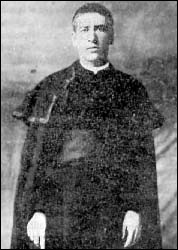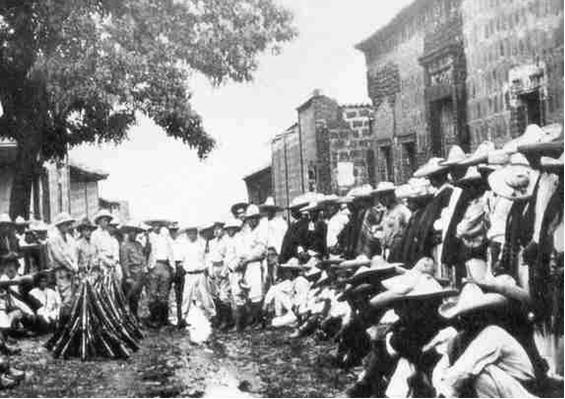AHA Today , Current Events in Historical Context , From the National History Center
Mexican Migration History in the Era of Border Walls
In March 2015, I submitted the final page proofs for my book on Mexican migration to the United States. In June of that same year, Donald Trump gave his now-infamous speech in which he called Mexican immigrants drug dealers, rapists, and criminals. We all know what has happened since then: a nativist presidential campaign, a rhetorical battle with Mexico over the border wall, an upset election, and a growing number of deportations.
Now, nearly two years after the book’s publication, I find myself thinking often about what the book means, and how it is relevant, in the age of Trump.
My book, Mexican Exodus: Emigrants, Exiles, and Refugees of the Cristero War, investigates how a dramatic but little-known religious revolt shaped Mexican migration to the United States. The conflict was known as the Cristero War, and it took place from 1926–29, when Catholic partisans rose up in armed revolt against the anticlerical reforms of the Mexican Revolutionary government. Although the war officially ended after the Mexican Catholic hierarchy signed a peace accord with the government, sporadic uprisings continued into the 1930s. During the war years, there were battles all over the country, but the fighting was particularly intense in the west-central states of Jalisco, Guanajuato, and Michoacán, where the Catholic Church had historically been strongest.
These states also comprised the most important sending region in a great wave of Mexican migration to the United States that began during the early 1920s and continued until the Great Depression. The geographic and temporal connections between Mexican migration and the Cristero War meant that most Mexicans in the United States during the 1920s and 1930s had been impacted in some way by the conflict: many fled Mexico as a direct result of the Cristero War, and even those who had left beforehand had friends and family who were involved.
During archival work in state and church archives on both sides of the border, I found abundant evidence that Mexican migrants responded to the war from the United States. Given that so many of them came from the deeply religious west-central region, I was not surprised to find that support for the Cristero cause was widespread wherever there were Mexican migrant communities, particularly in the growing Mexican barrios of San Antonio, El Paso, Los Angeles, and Chicago.
Throughout the 1920s and 1930s, Mexican migrants in these places participated in prayer rallies, public marches, and political campaigns meant to support the Cristeros and shame the anticlerical Mexican government. Many migrants even raised money to buy weapons for Cristero troops in the battlefields; a few recruited soldiers from their migrant communities, and tried to launch revolts along the border. Because these migrants collaborated with each other, as well as with like-minded people in the homeland, I refer to them in my book as the “Cristero diaspora.”

Saint Toribio Romo was a Cristero priest and martyr who is considered the patron saint of Mexican, and particularly undocumented, migrants. Wikimedia Commons
These Cristero supporters never succeeded in changing the outcome of the war. They didn’t have the full support of the US Catholic Church or the US government, and some of their actions ran afoul of US neutrality laws, which prohibited the sale of weapons to any opponents of the sitting Mexican government. Furthermore, plenty of Mexican migrants at the time supported the Revolutionary Mexican government, and denounced the activities of the Cristero diaspora to Mexican consular officials.
Nevertheless, their efforts—and the war itself—were long remembered by their descendants on both sides of the border, and memories of the Cristero War helped shape Mexican American religiosity for decades afterward. To this day, many Mexican migrants still come from the same west-central region where the war was most intensely fought, and they and their families recount and remember the myths and legends of the conflict. The power of these memories can be seen in the veneration of Santo Toribio Romo, a Cristero priest and martyr who has come to be regarded as the patron saint of Mexican migrants, particularly undocumented migrants who cross the border.
It has been 90 years since the beginning of the Cristero War, and Mexican migration has undergone many fluctuations in the intervening decades: deportation waves (such as the repatriations of the 1930s and Operation Wetback in the early 1950s); a surge in undocumented immigration since the 1970s; and a very recent decline in Mexican migration. In the contentious atmosphere of today, when Mexican immigrants are cast as scapegoats for much larger economic and problems, it’s important to keep the following in mind:
- First, migration patterns are always shaped by events and developments in the sending region. In the United States, we tend to view migration as something we can control unilaterally, through our own laws and policies. Without an informed understanding of the political and economic conflicts going on in the world outside our borders, we can’t predict or interpret migration patterns, and we can’t craft a coherent response.
- Second, most migrant communities are deeply affected—and sometimes, deeply divided—by the politics of their homeland. Scholars and the media should not assume that migrants from the same country are automatically in solidarity with each other, or that they will all vote the same way.
- Third and finally, the complex history of Mexican migration and Mexican American community formation is not widely understood outside of academia. Many of my students initially view Mexican migration as a contemporary phenomenon related strictly to economic forces. When I talk to them about the Cristero diaspora, they begin to realize that Mexican migration has a deep history; that Mexican migrants have been political and religious refugees; and that the reasons for contemporary migration are complex and contingent.
Mexican migration is not a problem that can be “solved” by something as simplistic as a wall along the border. In the era of Trump, then, it is to be hoped that the history of migration can be deployed to generate a clearer understanding of the present.
Established by the AHA in 2002, the National History Center brings historians into conversations with policymakers and other leaders to stress the importance of historical perspectives in public decision-making. Today’s author, Julia Young, recently presented in the NHC’s Washington History Seminar program on “Mexican Exodus: Emigrants, Exiles, and Refugees of the Cristero War.”
This post first appeared on AHA Today.
Julia Young is assistant professor of history at the Catholic University of America in Washington, DC. She is the author of Mexican Exodus: Emigrants, Exiles, and Refugees of the Cristero War (Oxford University Press, 2015). She holds a PhD in history from the University of Chicago (2009).
Tags: AHA Today Current Events in Historical Context From the National History Center Latinx History Migration/Immigration/Diaspora
Comment
Please read our commenting and letters policy before submitting.







